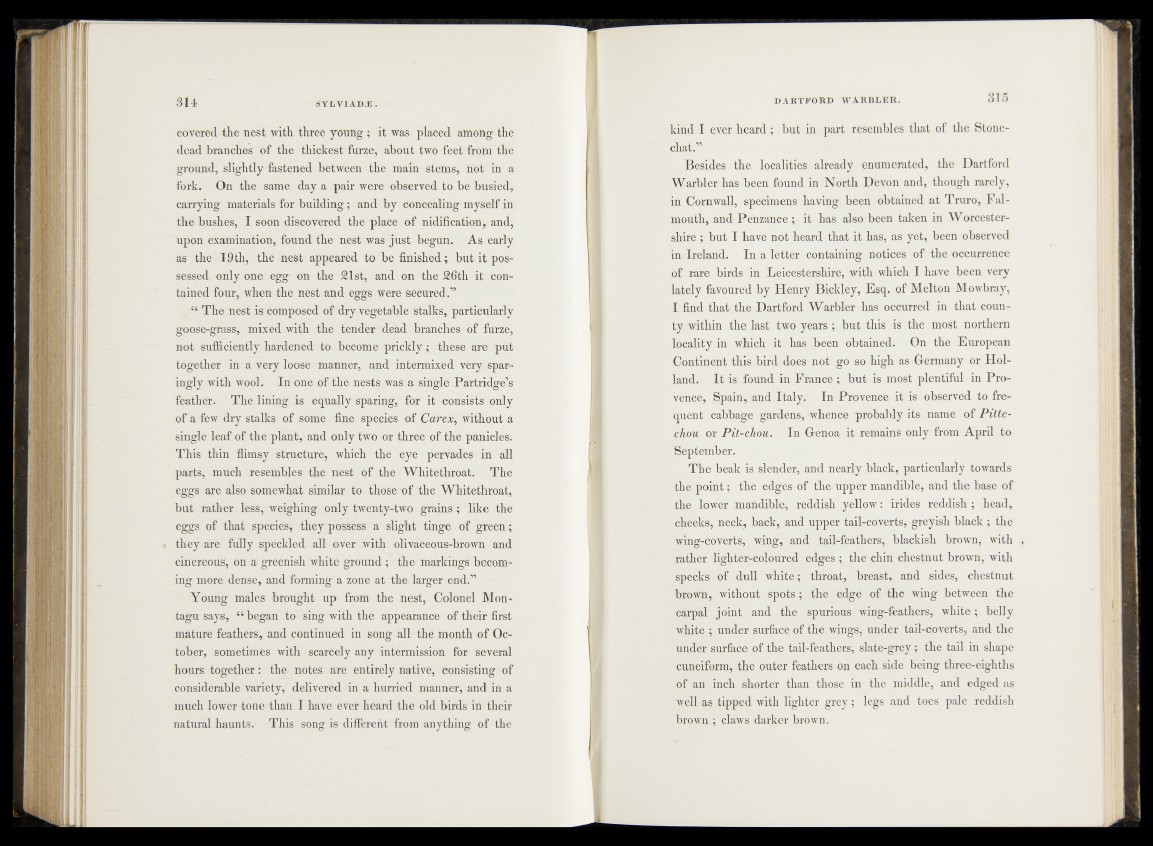
covered the nest with three young; it was placed among the
dead branches of the thickest furze, about two feet from the
ground, slightly fastened between the main stems, not in a
fork. On the same day a pair were observed to be busied,
carrying materials for building; and by concealing myself in
the bushes, I soon discovered the place of nidification, and,
upon examination, found the nest was just begun. As early
as the 19th, the nest appeared to be finished; but it possessed
only one egg on the 2 1 st, and on the 26th it contained
four, when the nest and eggs were secured.”
** The nest is composed of dry vegetable stalks, particularly
goose-grass, mixed with the tender dead branches of furze,
not sufficiently hardened to become prickly; these are put
together in a very loose manner, and intermixed very sparingly
with wool. In one of the nests was a single Partridge’s
feather. The lining is equally sparing, for it consists only
of a few dry stalks of some fine species of Carex, without a
single leaf of the plant, and only two or three of the panicles.
This thin flimsy structure, which the eye pervades in all
parts, much resembles the nest of the Whitethroat. The
eggs are also somewhat similar to those of the Whitethroat,
but rather less, weighing only twenty-two grains ; like the
eggs of that species, they possess a slight tinge of green;
they are fully speckled all over with olivaceous-brown and
cinereous, on a greenish white ground ; the markings becoming
more dense, and forming a zone at the larger end.”
Young males brought up from the nest, Colonel Montagu
says, “ began to sing with the appearance of their first
mature feathers, and continued in song all the month of October,
sometimes with scarcely any intermission for several
hours together: the notes are entirely native, consisting of
considerable variety, delivered in a hurried manner, and in a
much lower tone than I have ever heard the old birds in their
natural haunts. This song is different from anything of the
kind I ever heard ; but in part resembles that of the Stone-
chat.”
Besides the localities already enumerated, the Dartford
Warbler has been found in North Devon and, though rarely,
in Cornwall, specimens having been obtained at Truro, Falmouth,
and Penzance ; it has also been taken in Worcestershire
; but I have not heard that it has, as yet, been observed
in Ireland. In a letter containing notices of the occurrence
of rare birds in Leicestershire, with which I have been very
lately favoured by Henry Bickley, Esq. of Melton Mowbray,
I find that the Dartford Warbler has occurred in that county
within the last two years ; but this is the most northern
locality in which it has been obtained. On the European
Continent this bird does not go so high as Germany or Holland.
It is found in France ; but is most plentiful in Provence,
Spain, and Italy. In Provence it is observed to frequent
cabbage gardens, whence probably its name of Pitte-
chou or Pit-chou. In Genoa it remains only from April to
September.
The beak is slender, and nearly black, particularly towards
the point; the edges of the upper mandible, and the base of
the lower mandible, reddish yellow: irides reddish; head,
cheeks, neck, back, and upper tail-coverts, greyish black ; the
wing-coverts, wing, and tail-feathers, blackish brown, with
rather lighter-coloured edges ; the chin chestnut brown, with
specks of dull white; throat, breast, and sides, chestnut
brown, without spots; the edge of the wing between the
carpal joint and the spurious wing-feathers, white; belly
white ; under surface of the wings, under tail-coverts, and the
under surface of the tail-feathers, slate-grey; the tail in shape
cuneiform, the outer feathers on each side being three-eighths
of an inch shorter than those in the middle, and edged as
well as tipped with lighter grey; legs and toes pale reddish
brown ; claws darker brown.